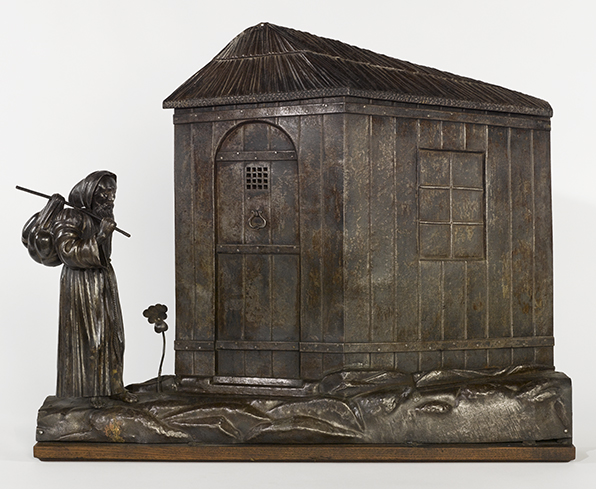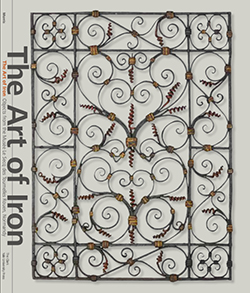
June 9–September 16, 2018
working with iron
Inn Sign, “À l’Hermitage”
French
c. 1800–1825
Wrought iron and rolled iron, cut and embossed
Réunion des Musées Métropolitains, Rouen, Normandy, LS.4139
© Agence La Belle Vie – Nathalie Landry
Iron Forging Technique
Although modern blacksmiths have access to some motorized equipment, in essence the craft has not changed. To create the raw materials of wrought iron, iron ore is extracted from the earth and smelted to remove most of the impurities, resulting in what is essentially pure elemental iron. This substance is malleable when hot, yet hard and durable when cooled. The ironsmith shapes the material by heating it and manipulating the red-hot metal with various tools. Rods of iron are shaped and bent into the desired forms—often scrolled and sinuous—and welded or fastened together with balls, collars, screws, and rivets.
Iron can also be rolled into sheet metal and cut to a desired shape. These thin sheets of metal are often decorated by the repoussé technique, also known as embossing, whereby the artisan uses tools to push the metal from the back, creating a raised form or decoration on the front. Surface details are added or refined by working the front of the piece with hammers, punches, and chisels. At times small components are stamped, hammered into a mold, or cast by pouring liquid metal into small molds and then welding into place. Many of the works in this exhibition use a variety of these methods.
Wrought iron is used less frequently today. It has been replaced by modern materials, including steel, glass, plastics, and other durable, lightweight substances that have changed the way buildings and products of every type are produced. In the long history of human-made objects, though, these substances are relative newcomers. For many centuries hand-forged iron was found everywhere—on buildings, in home implements, in tools and machinery, and in many other applications. Although no longer present in the same quantity, examples of wrought iron (old and new) can still be found in many places in America and Europe.
The catalogue for The Art of Iron includes essays by Kathleen M. Morris, the Clark Art Institute curator of decorative arts, and by the Musée Le Secq’s former and current curators, Anne-Charlotte Cathelineau and Alexandra Bosc. Softcover, 112 pages. Distributed by Yale University Press. Call the Museum Store at 413 458 0520 to order.


